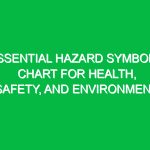Welcome to Our Toolbox Talk
Hello everyone! Today, we’re here to discuss a crucial aspect of our Workplace Safety: Line of Fire Hazards. This Toolbox Talk aims to equip you with the knowledge and tools to recognize and mitigate these Hazards effectively. We all play a vital role in maintaining a safe Environment, and understanding these risks is an essential part of that responsibility.
What Are Line of Fire Hazards?
Line of Fire Hazards refer to the potential risk of injury when workers are positioned in a way that exposes them to moving objects or energy sources. This can include anything from machinery and tools to vehicles and falling objects. When we talk about being in the “line of fire,” we’re discussing the areas where a worker could be struck or injured by something moving or being projected.
Why Is It Important to Understand Line of Fire Hazards?
Understanding Line of Fire Hazards is vital for several reasons:
- Injury Prevention: Recognizing these hazards reduces the likelihood of accidents and injuries.
- Workplace Safety Culture: A comprehensive understanding fosters a culture of Safety, where everyone looks out for one another.
- Regulatory Compliance: Adhering to Safety Guidelines and Regulations helps us avoid penalties and ensures a safer environment.
Identifying Line of Fire Hazards
Identifying these hazards requires vigilance and awareness. Here are some common sources of Line of Fire Hazards in our work environment:
- Moving Machinery: Equipment such as forklifts, cranes, and conveyor belts can pose significant risks if proper protocols aren’t followed.
- Falling Objects: Tools or materials that could fall from heights pose a serious threat to workers below.
- Electrical Hazards: Equipment that could cause electrical arcs or shocks when improperly handled.
- Workplace Traffic: Areas where foot traffic and vehicle movement intersect can create dangerous situations.
Real-Life Example
Let’s think about a situation in our workplace. Imagine a forklift moving pallets in a warehouse. If a worker is standing too close to the aisle while not paying attention, they could easily step into the path of the forklift. This scenario illustrates how being in the Line of Fire can lead to severe injuries. Always maintain a safe distance from moving equipment and ensure you’re aware of your surroundings.
Best Practices to Mitigate Line of Fire Hazards
Now that we understand what Line of Fire Hazards are, let’s discuss how we can minimize these risks:
- Keep Clear Zones: Maintain clear zones around machinery and high-traffic areas to prevent accidental entry.
- Use Personal Protective Equipment (PPE): Always wear appropriate PPE, such as helmets, safety glasses, and high-visibility vests, to protect against potential injuries.
- Follow Lockout/Tagout Procedures: Ensure that machinery is properly locked out and tagged out before Maintenance or repairs.
- Conduct Regular Safety Audits: Regularly inspect work areas to identify potential hazards and take corrective actions.
Engaging Employees in Safety
It’s essential for everyone to take part in creating a safer work environment. Engage in discussions about Line of Fire Hazards with your colleagues. Share your experiences and insights. Here are a few questions to consider:
- Can you identify any areas in our workplace where Line of Fire Hazards exist?
- What measures can we implement to improve safety in these areas?
Regulations and Standards
Adhering to safety regulations is a fundamental part of our work. The Occupational Safety and Health Administration (OSHA) provides guidelines that help us manage Line of Fire Hazards. Understanding and following these regulations not only keeps us compliant but also ensures a safer work environment for everyone.
Additionally, our company has its own safety protocols. Familiarize yourself with our safety manual, which outlines our policies regarding Line of Fire Hazards and other safety-related topics. Compliance with these guidelines is not just a legal obligation; it’s a moral one that protects you and your coworkers.
Conclusion
Today, we’ve covered the importance of understanding and mitigating Line of Fire Hazards. By being aware of these risks and taking proactive steps, we can significantly reduce the chances of accidents and injuries in our workplace. Remember, safety is a shared responsibility, and each of us plays a crucial role in fostering a safe working environment.
Thank you for your attention and commitment to safety. Let’s continue to work together to ensure that we all come home safe at the end of the day. If you have any questions or concerns regarding Line of Fire Hazards, please feel free to share them now.


